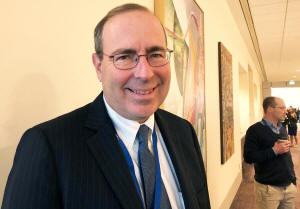Fed's rate path balances inflation fight and pandemic unknowns, Barkin
says
 Send a link to a friend
Send a link to a friend
 [March 19, 2022] By
Howard Schneider [March 19, 2022] By
Howard Schneider
BALTIMORE (Reuters) - The rate increases
projected by Federal Reserve officials this week represented a
"balancing act" between the need to begin normalizing monetary policy in
the face of high inflation, while guarding against a fast tightening of
credit that could damage the economy, Richmond Fed President Thomas
Barkin said on Friday.
"The rate path we announced this week shouldn't drive economic decline.
We are still far from the level of rates that constrains the economy,"
Barkin told a Maryland Bankers Association economic forum in what were
his first public remarks since the U.S. central bank on Wednesday
approved a quarter-percentage-point increase in the target federal funds
rate.
"Think of it as an indication that the extraordinary support of the
pandemic era is unwinding," Barkin said. The federal funds rate has been
near zero since March of 2020.

New projections showed Fed officials at the median envision raising that
rate to 1.9% by the end of this year, still below the roughly 2.4% level
that policymakers feel would have a neutral impact on economic
decisions.
Amid calls by some officials for faster hikes in borrowing costs, Barkin
said the Fed could move more quickly, including in half-percentage-point
increments, "if we start to believe that is necessary to prevent
inflation expectations from unanchoring."
[to top of second column] |

Federal Reserve Bank of Richmond President Thomas Barkin poses
during a break at a Dallas Fed conference on technology in Dallas,
Texas, U.S., May 23, 2019. REUTERS/Ann Saphir/File Photo

But he added that such a shift didn't seem to be happening so far, and in the
meantime it remained uncertain how quickly some of the lingering problems from
the pandemic - from supply chain troubles to the skewed demand for goods - will
be resolved. Until that becomes clearer, Barkin said, it will be hard to know
just how fast the Fed should raise interest rates.
"Setting the right pace for rate increases is a balancing act - we normalize
rates to contain inflation, but if we over-correct, we can negatively impact
employment, which is the other part of our dual mandate. And we have some time
to get to a neutral position," Barkin said.
"Inflation and employment are still being heavily influenced by pandemic-era
supply and participation pressures - and more recently, the war on Ukraine - and
it will take a while for us to understand and meet the dynamics of the
post-pandemic economy," he added.
(Reporting by Howard Schneider; Editing by Paul Simao)
[© 2022 Thomson Reuters. All rights
reserved.]
This material may not be published,
broadcast, rewritten or redistributed.
Thompson Reuters is solely responsible for this content. |